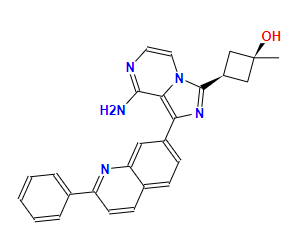Linsitinib, a new drug in development

Molecular Formula: C26H23N5O
Formula Weight: 421.49
The submission of preclinical results suggesting that linsitinib, a small molecule inhibitor of the insulin-like growth factor I receptor (IGF-1R), decreases immunological responses in a mouse model of TED was disclosed by Sling Therapeutics on May 15, 2023. The American Association of Immunologists (AAI) Annual Meeting will feature a presentation of these findings from May 11–15, 2023, in Washington, D.C. Reduced inflammation in the retro-ocular fat and muscle is one of the clinically significant endpoints that have improved significantly, according to the findings. In the worldwide Phase 2b LIDS clinical study, the business is testing linsitinib for the treatment of active, moderate-to-severe thyroid eye disease. In the preclinical investigation, linsitinib was administered to mice for four weeks who had generated Graves' disease, a typical TED symptom. synthesized medications sold to the general public. Linsitinib decreased t-cell and macrophage infiltration in orbital muscle and adipose tissue by up to 80%, as well as orbital fat accumulation and muscle edema, whether it was given as a preventative measure or after illness induction.
With regards to Thyroid Eye Disease (TED)
TED is a crippling autoimmune illness that strikes 20,000 Americans and a comparable number of Europeans every year. Thyroid stimulating hormone receptor autoantibodies (TSHR-Abs) are common as a result of malfunction of the IGF-1R signaling system, and they promote the development of extra fibrous tissue behind the eye. The eye may advance as a result of this inflammation, or the eye and eyelids may swell and get red. As the illness worsens, discomfort, eye swelling, and double vision are all symptoms. synthesized medications sold to the general public. The majority of individuals with TED are female and have Graves' disease-related hyperthyroidism most frequently.
